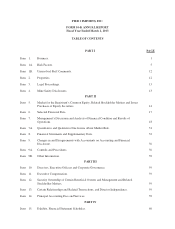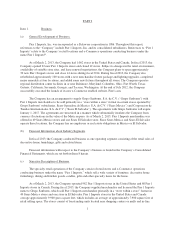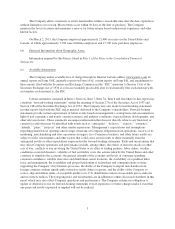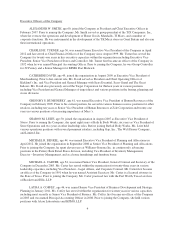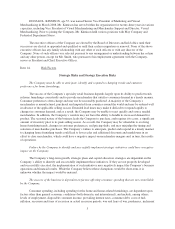Pier 1 2013 Annual Report Download - page 14
Download and view the complete annual report
Please find page 14 of the 2013 Pier 1 annual report below. You can navigate through the pages in the report by either clicking on the pages listed below, or by using the keyword search tool below to find specific information within the annual report.Failure to attract and retain an effective management team or changes in the costs or availability of a
suitable workforce to manage and support the Company’s stores, distribution facilities and e-Commerce business
could negatively affect the business.
The Company’s success is dependent, in a large part, on being able to successfully attract, motivate and
retain a qualified management team and employees. Sourcing qualified candidates to fill important positions
within the Company, especially management, in the highly competitive retail environment may prove to be a
challenge. The inability to recruit and retain such individuals could result in turnover in the home office, stores
and the distribution facilities, which could have a negative effect on the business. Management will continue to
assess the Company’s compensation and benefit program in an effort to attract future qualified candidates and
retain current experienced management team members. The Company does not believe that its compensation
policies, principles, objectives and practices are structured to promote inappropriate risk taking by its executives
nor inappropriate risk-taking by its employees whose behavior would be most affected by performance-based
incentives. The Company believes that the focus of its overall compensation program encourages its employees
to take a balanced approach that focuses on increasing and sustaining Pier 1 Imports’ profitability.
Occasionally the Company experiences union organizing activities in non-unionized distribution
facilities. Similar activities could also occur in the stores. These types of activities may result in work slowdowns
or stoppages and higher labor costs. Any increase in costs associated with labor organization at distribution
facilities could result in higher costs to distribute inventory and could negatively impact merchandise margins.
Failure to successfully manage the Company’s e-Commerce operations could negatively affect the
business.
The Company successfully executed the launch of its e-Commerce operations in the United States during
fiscal 2013. Successful operation of the e-Commerce initiatives are dependent on the Company’s ability to
maintain uninterrupted availability of the Company’s website and supporting applications, adequate inventory
levels, timely fulfillment of customer orders, and accurate shipping of undamaged product. In addition, the
Company’s call center must maintain a high standard of customer care. Failure to successfully manage this
process may negatively impact sales, result in the loss of customers, and damage the Company’s reputation.
The Company operates in a highly competitive retail environment with companies offering similar
merchandise, and if customers are lost to the Company’s competitors, sales could decline.
The Company operates in the highly competitive specialty retail business, both in its stores and
e-Commerce business, competing with specialty sections of large department stores, home furnishing retailers,
small specialty stores and mass merchandising discounters. Management believes that as it is competing for
sales, it does so on the basis of pricing and quality of products, constantly changing merchandise assortment,
visual presentation of its merchandise and customer service. The Company could also experience added short-
term competition when other retailers are liquidating merchandise for various reasons. If the Company is unable
to maintain a competitive position, it could experience negative pressure on retail prices and loss of customers,
which in turn could result in reduced merchandise margins and operating results.
The Company’s business is subject to seasonal variations, with a significant portion of its sales and
earnings occurring during two months of the year.
Approximately 25% of the Company’s sales generally occur during the November-December holiday
selling season. Failure to predict consumer demand correctly during these months could result in lost sales or
gross margin erosion if merchandise must be marked down significantly to clear inventory.
The Company’s business may be harmed by adverse weather conditions and natural disasters.
Extreme or undesirable weather can negatively affect customer traffic in retail stores as well as customer
shopping behavior. Natural disasters such as earthquakes, weather phenomena, and events causing infrastructure
8




